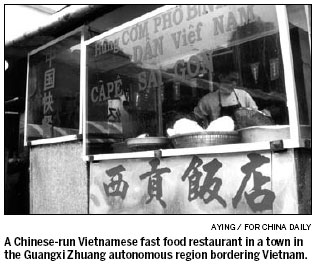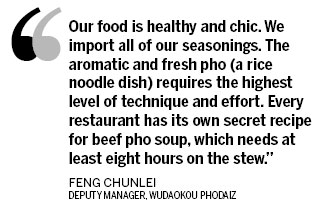Vietnamese chefs cook up a storm
BEIJING - When Haanz Lee, founder of Vietnamese restaurant Phodaiz, studied abroad, he noticed that the sweet and spicy Vietnamese food enjoyed much popularity among Europeans. After returning to China, Lee planned to promote Vietnamese food to a wider Chinese audience.

The entrepreneur spent much effort investing in the Phodaiz brand. The restaurant's Chinese name "Fu Dai" is short for "Xingfu Shidai (a Happy Era". Lee also designed the restaurant's logo, a Vietnamese man in a conical Asian hat.
He also placed Phodaiz in malls in commercial districts. Right before the 2008 Olympics, Lee and his team opened the Wudaokou's U-Center branch.
Last year, Vietnamese restaurant Phodaiz created a promotional event with China's largest user-generated and edited urban consumption portal Dianping.com. The event attracted 2,919 Beijingers to group-buy Phodaiz's discount coupons.
"The first few Vietnamese restaurants in Beijing, such as Nuage, serve delicious delicacies, but remain relatively obscure," said Zou Yadan, a freelance food writer and lover of Vietnamese food.
A South Korean who grew up in China, Lee opened the first Phodaiz in July 2007 at The Place in Beijing with his Chinese friends Feng Chunlei, Ding Peng, and Zhang Wei. Feng and Ding both serve as deputy managers, while Zhang Wei is the senior chef.
Feng, the 26-year-old deputy manager of the Wudaokou Phodaiz, said that business at Wudaokou is better because many university students frequent the restaurant. The Place, in contrast, hosts mostly white collar workers.
"Our food is healthy and chic," Feng said. "We import all of our seasonings. The aromatic and fresh pho (a rice noodle dish) requires the highest level of technique and effort. Every restaurant has its own secret recipe for beef pho soup, which needs at least eight hours on the stew." The Phodaiz version of the tasty pho is called "all in one beef".

Hanoi spring roll is another Vietnamese speciality. "Many Vietnamese restaurants in America serve just rolls and pho," Zou said. Phodaiz's rolls have at least 10 ingredients and include do-it-yourself versions and pizza rolls.
Zhang Wei learned how to make Southeast Asian food before refining his Vietnamese cooking skills. "We learned the whole combination of Southeast Asian cuisine. There isn't a place in Beijing for chefs to learn Vietnamese food yet."
Similarly, Ding Peng worked as a chef since 1993 for many different types of cuisine before learning how to make Vietnamese food.
Phodaiz chefs have chances to exhibit their talents and creativity every three to six months, when managers decide to update its menu. "They invent new dishes for the managers to taste and judge," Feng said. "We just filled several long tables with new dishes on June 24."
According to Ding, the process was successful and Phodaiz will update the menu again in mid-July. "We will not only work on improving the quality of our dishes, but also our service and dining environment," he said.
Ding's urge for improvement is necessary. Phodaiz faces fierce competition in a city that champions culinary diversity. Beijing provides options across the nation and the globe to its urban dwellers. According to listings on Dianping.com, Beijing has 930 Japanese restaurants, 982 Korean restaurants, and 206 Southeast Asian restaurants.
The Western restaurant category includes not only choices from Europe and America, but also Russia, the Mediterranean, and Latino cuisine.
By combining all these different regions, Western restaurants topped the other categories with 1,693 listings on Dianping.com. The Southeast Asian category similarly includes fusion/eclectic restaurants as well as options ranging from Indian curry to the aforementioned Vietnamese pho.
The unique taste of Vietnamese coffee also enjoys international fame.
Coffee was introduced into Vietnam by the French colonialists in the 19th century. Because of limitations on the availability of fresh milk, the French and Vietnamese began to use sweetened condensed milk with a dark roast coffee. Strong iced coffee is a popular beverage, served with sweetened condensed milk at the bottom of the cup and tastes as rich as melted ice cream, experts say.
At Phodaiz, managers import Vietnamese-grown dark roast coffee powder. Vietnamese coffee is made with a special metal distiller. The inexpensive and portable coffee maker is used in place of electronic ones, customized to sit on a single cup while the coffee drips down.
"Vietnamese coffee has a unique taste." Zou said as she sipped black iced coffee.


















